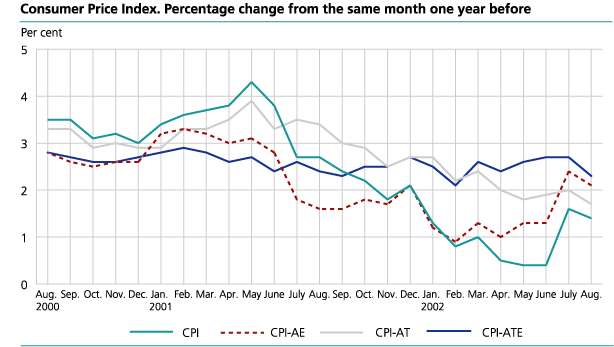Content
Published:
This is an archived release.
Decrease in the consumer prices
The Consumer Price Index (CPI) declined by 0.3 per cent from July to August. The price decrease was mainly caused by lower prices of clothing, food and airline fares. The year-to-year change in the CPI fell from 1.6 per cent in July to 1.4 per cent in August.
The CPI stood at 109.6 (1998=100) in August in comparison with 108.1 in August last year. The CPI adjusted for tax changes and excluding energy products (CPI-ATE) was 2.3 per cent in August, down from 2.7 per cent in July.
The consumer prices down 0.3 per cent from July to August
The summer sales continued in August and the prices of clothing and footwear fell by 3.3 per cent. The clothing prices dropped 3.4 per cent while the prices of footwear declined by 2.7 per cent. Audio-visual equipment and furniture were characterized by some sales activities as well.
The prices of food and non-alcoholic beverages declined by 0.6 per cent. The decrease was mainly caused by a seasonal reduction in the prices of fruit and vegetables. Potatoes, grapes and paprika had the greatest price decline.
Household payments in kindergartens dropped 1.9 per cent. The public kindergarten fees declined, while the private kindergarten fees increased. For further details, see Household Payments in Kindergartens, August 2002 .
Both rentals for housing and costs of owner-occupied housing declined slightly in August. As of the August index part owners in housing co-operatives are defined as owners and therefore included in costs of owner-occupied housing and not in rentals for housing as earlier. The tariffs on electricity have dropped every month since January, but in August the prices rose by 0.6 per cent. The costs of transporting energy caused the increase.
The prices in the transport sector went up 0.2 per cent, mainly due to a rise in the petrol prices. On the other hand it was registered a decrease of 2.3 per cent in the prices on passenger transport by air.
Followed by a great seasonal reduction in the prices of accommodation services in July, the prices rose considerably in August by 7.6 per cent. Increases in prices of dental services and after school activities
since last surveys in January 2002 were also registered.
Year-to-year change: Prices up 1.4 per cent
Rentals are still the main contributing factors to the CPI growth. Costs for owner-occupied housing and rentals for housing have increased by 5.6 and 4.9 per cent respectively. The prices of food and non-alcoholic beverages have also been an important contributor to the overall growth in August with an increase of 2.9 per cent. The prices of dairy products have increased the most. Also higher prices in the service sector have been registered.
The tariffs on electricity increased from July to August, but on the year-to-year basis the prices are 13.9 per cent lower than in August last year. The CPI excluding energy products (CPI-AE) has increased by 2.1 per cent. The price developments of clothing and airline fares also contributed to dampen the price increase.
The CPI adjusted for tax changes (CPI-AT) was 1.7 per cent in August. Lower taxes reduced the consumer price growth by 0.3 percentage points. CPI-ATE was 2.3 per cent.
Change in the year-to-year growth: Decrease
The year-to-year growth in the CPI went from 1.6 per cent in July to 1.4 per cent in August. This decrease is mainly due to the price development of clothing. The seasonal sales of clothing was considerable stronger in August this year compared with August last year. The price developments of food and rentals, among other things, have also contributed to the decrease.
CPI-AT fell from 2.0 per cent in July to 1.7 per cent in August while CPI-ATE went from 2.7 to 2.3 per cent.
New weights in the CPI
For the period of August 2002 to July 2003 the weights in the CPI are based on average expenditure shares of 1999, 2000 and 2001. See: Weights .
| The Consumer Price Index. 1998 = 100 |
| Index | Change in per cent | ||||||||||||||||||||||||||||||||||||||
|---|---|---|---|---|---|---|---|---|---|---|---|---|---|---|---|---|---|---|---|---|---|---|---|---|---|---|---|---|---|---|---|---|---|---|---|---|---|---|---|
| August 2002 | Juy 2002-August 2002 | Aug. 2001- Aug. 2002 | Jan.-Aug. 2001-Jan.-Aug. 2002 | ||||||||||||||||||||||||||||||||||||
| CPI All-item index | 109.6 | -0.3 | 1.4 | 0.9 | |||||||||||||||||||||||||||||||||||
| Food and non-alcoholic beverages | 101.7 | -0.6 | 2.9 | -4.0 | |||||||||||||||||||||||||||||||||||
| Alcoholic beverages and tobacco | 113.6 | 0.1 | -0.4 | -0.7 | |||||||||||||||||||||||||||||||||||
| Clothing and footwear | 84.4 | -3.3 | -7.4 | -4.7 | |||||||||||||||||||||||||||||||||||
| Housing, water, electricity, fuels | 118.1 | - | 2.3 | 3.2 | |||||||||||||||||||||||||||||||||||
| Furnishings household equipment | 102.5 | -0.8 | 0.4 | 0.2 | |||||||||||||||||||||||||||||||||||
| Health | 117.6 | 0.9 | 5.1 | 3.8 | |||||||||||||||||||||||||||||||||||
| Transport | 112.7 | 0.2 | 1.0 | 0.7 | |||||||||||||||||||||||||||||||||||
| Communications | 89.4 | -0.6 | 2.3 | 2.0 | |||||||||||||||||||||||||||||||||||
| Recreation and culture | 105.9 | -0.5 | 1.0 | 1.1 | |||||||||||||||||||||||||||||||||||
| Education | 125.6 | - | 10.4 | 10.4 | |||||||||||||||||||||||||||||||||||
| Restaurants and hotels | 116.5 | 0.9 | 4.0 | 4.3 | |||||||||||||||||||||||||||||||||||
| Miscellaneous goods and services | 114.7 | -0.3 | 3.1 | 3.0 | |||||||||||||||||||||||||||||||||||
| CPI-AE | 108.7 | -0.5 | 2.1 | 1.5 | |||||||||||||||||||||||||||||||||||
| CPI-AT | -0.3 | 1.7 | 2.1 | ||||||||||||||||||||||||||||||||||||
| CPI-ATE | -0.4 | 2.3 | 2.5 | ||||||||||||||||||||||||||||||||||||
Contact
-
Statistics Norway's Information Centre
E-mail: informasjon@ssb.no
tel.: (+47) 21 09 46 42
-
Konsumprisindeksen
E-mail: konsumprisindeksen@ssb.no
tel.: (+47) 62 88 56 34
-
Camilla Rochlenge
E-mail: camilla.rochlenge@ssb.no
tel.: (+47) 40 90 23 72
-
Kjersti Nyborg Hov
E-mail: kjersti.nyborg.hov@ssb.no
tel.: (+47) 40 90 23 63
-
Gunnar Larsson
E-mail: gunnar.larsson@ssb.no
tel.: (+47) 40 90 26 79
-
Trym Kristian Økland
E-mail: trym.okland@ssb.no
tel.: (+47) 46 81 09 15

